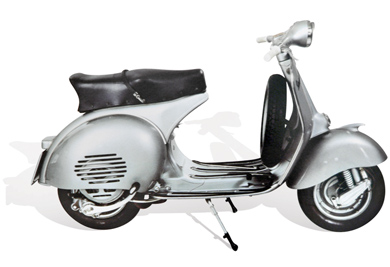Postage free from 99€ (DE)
High customer satisfaction

In 1957, a Vespa GS 150 VS1T was offered for the first time. It was rightly named Gran Sport, as ten years of experience in competition riding had been incorporated into the model. The engine is derived from the Sei Giorni factory racers. No Vespa has ever had as much power as the GS.
The engine has a square design (57 mm bore x 57 mm stroke) and a direct intake with Dell'Orto UB23S3 (main jet: 103, idle jet: 50, mixing pipe: 260 and E21 needle on 3rd notch from the top) carburetor. The clutch was reinforced to cope with the power. The engine of the GS 150 is famous for its turbine-like revving and 8 hp at 7,500 rpm was an official announcement at the time. Even if the factory specification of a top speed of 100 km/h could probably only be achieved in the rarest of cases, the GS 150 is a milestone. So you had to accept the 6 % mixture ratio for better or worse.
In terms of style, Piaggio also took its cue from the Sei Giorni racers, which were only delivered to selected Italian dealers in very small numbers at the time. The most striking feature, apart from the very elegant silver (MaxMeyer code 15005) in which the GS was delivered, is definitely the aerodynamically shaped leg shield. The design of the GS also heralded a completely new era in scooter construction.
The GS was marketed as a sports model and scooters developed into a status symbol. There was not much competition for Piaggio at the time; German and British scooters were not exactly the kind of thing that would tempt you out from behind the stove. And the big rival Innocenti couldn't really score with the D and LD models either. If we let our gaze wander further over the frugal bodywork of the GS, we notice the very large and high side covers, the low front mudguard with its highly polished nose and the handlebar head with its 115 mm headlight. The speedometer scale extends up to 120 km/h and the ignition lock integrated in the steering head also serves as a switch for various electrical consumers. The dark blue seat conceals the generously sized 12-liter fuel tank. The most striking feature of the GS 150 first series is the external cables on the handlebars.
The successor, the GS 150 VS2T, followed in 1956. Apart from the ignition system, only minor technical changes were made, such as the jetting of the carburetor and the connection of the exhaust manifold to the cylinder. The union nut has to go and from now on the exhaust is clamped to the exhaust manifold. The redesigned handlebar immediately catches the eye. Bowden cables and cables are now inside, the speedometer is white. The saddle is dark blue. The leg shield is protected from the rigors of everyday use by a chrome-plated mono slotted tube. Like its predecessor, the bike comes on so-called star rims with 3.50-10-inch tires.
Despite the new model year, nothing has changed on the GS 1957 VS3T compared to the previous year's model apart from the frame abbreviation. The key data remains the same.
With the GS 150 VS4T from 1958, changes were made again, albeit only minimal ones. From engine number VS4M 0045976, the Dell'Orto UB23S 3 is fitted with the following equipment: Main jet 103, idle jet 40, mixing tube 260, needle E21 on 3rd notch from the top. The rear brake pads are no longer mounted overlapping on a pin. For a better functioning brake, each pad is attached to its own pivot. The frame remains unchanged. The most striking feature is the rear tail light, which now has an integrated brake light. The very attractive rear light housing is chrome-plated, the plastic lens for the rear light is red and the lens for the brake light is orange. In addition, the locking mechanism for the side covers has been simplified.
The GS 150 VS5T was the last model series of the GS 150 to reach dealers in 1959 and was sold until 1961. With engine number 0070120, a new cylinder head with a so-called jockey cap shape is installed, which is intended to increase the elasticity of the engine. A Dell'Orto UB23S31 now took over the mixture preparation. The rated speed is now reduced to 7,000 rpm. The star rims are replaced by self-ventilating die-cast aluminum brake drums, the wheel hub of which is covered by a stainless steel cap. The square speedometer has given way to a larger, shell-shaped speedometer with a scale up to 120 km/h. The chrome-plated SIEM headlight trim ring has an integrated lampshade. On the first models, the rear light is painted in the vehicle color and the glass is orange/red. On later models, the housing is then chrome-plated and the glass is completely red. The dark blue seat is the most comfortable seat that has found its way onto the Gran Sport to date and its dark blue matches the silver metallic (MaxMeyer code 15005) perfectly. The trim strip on the mudguard has been revised and is much more delicate.
Frame numbers VS3 by year of manufacture:
1957: VS3T 23311-35310
Quantities: 12,000


